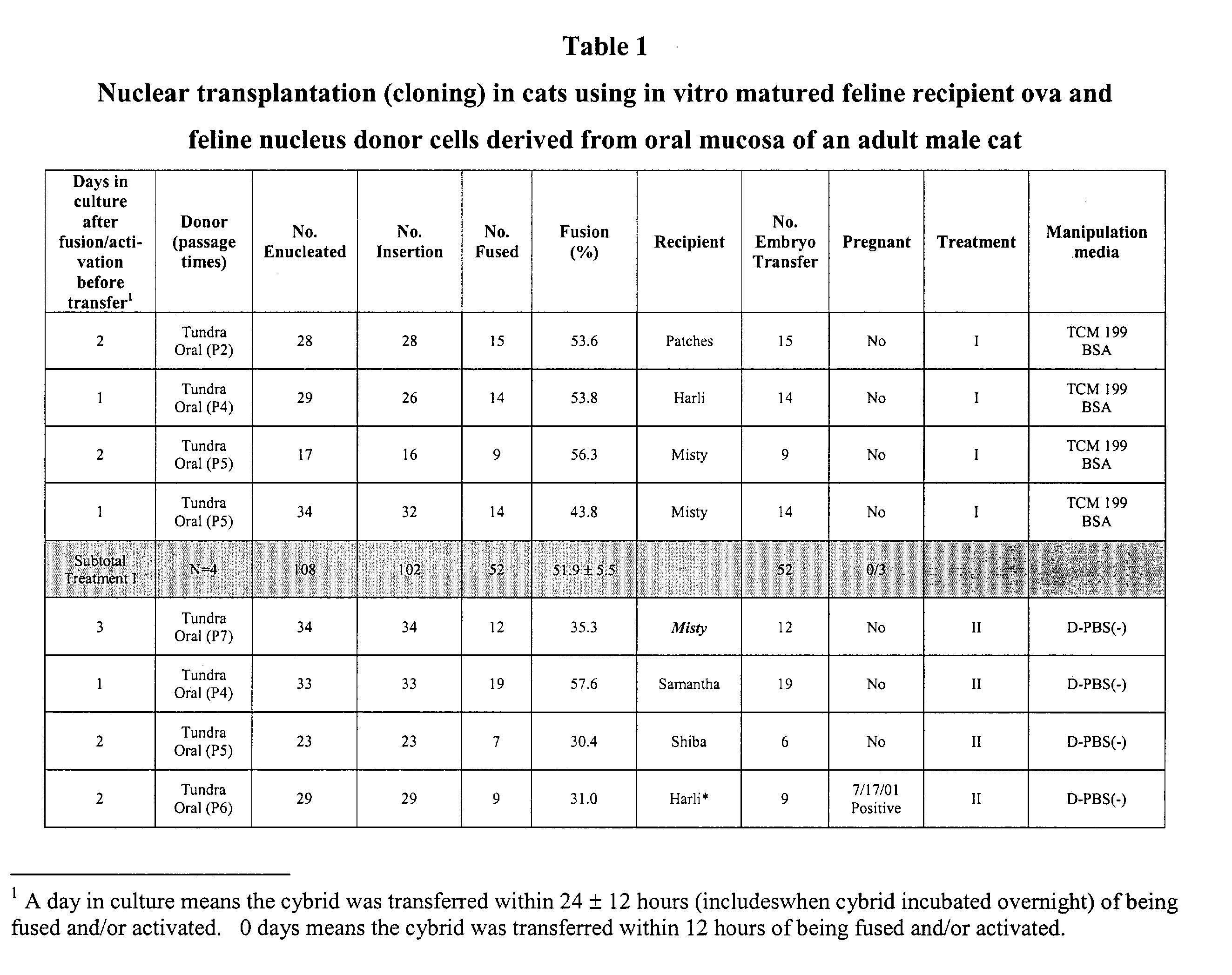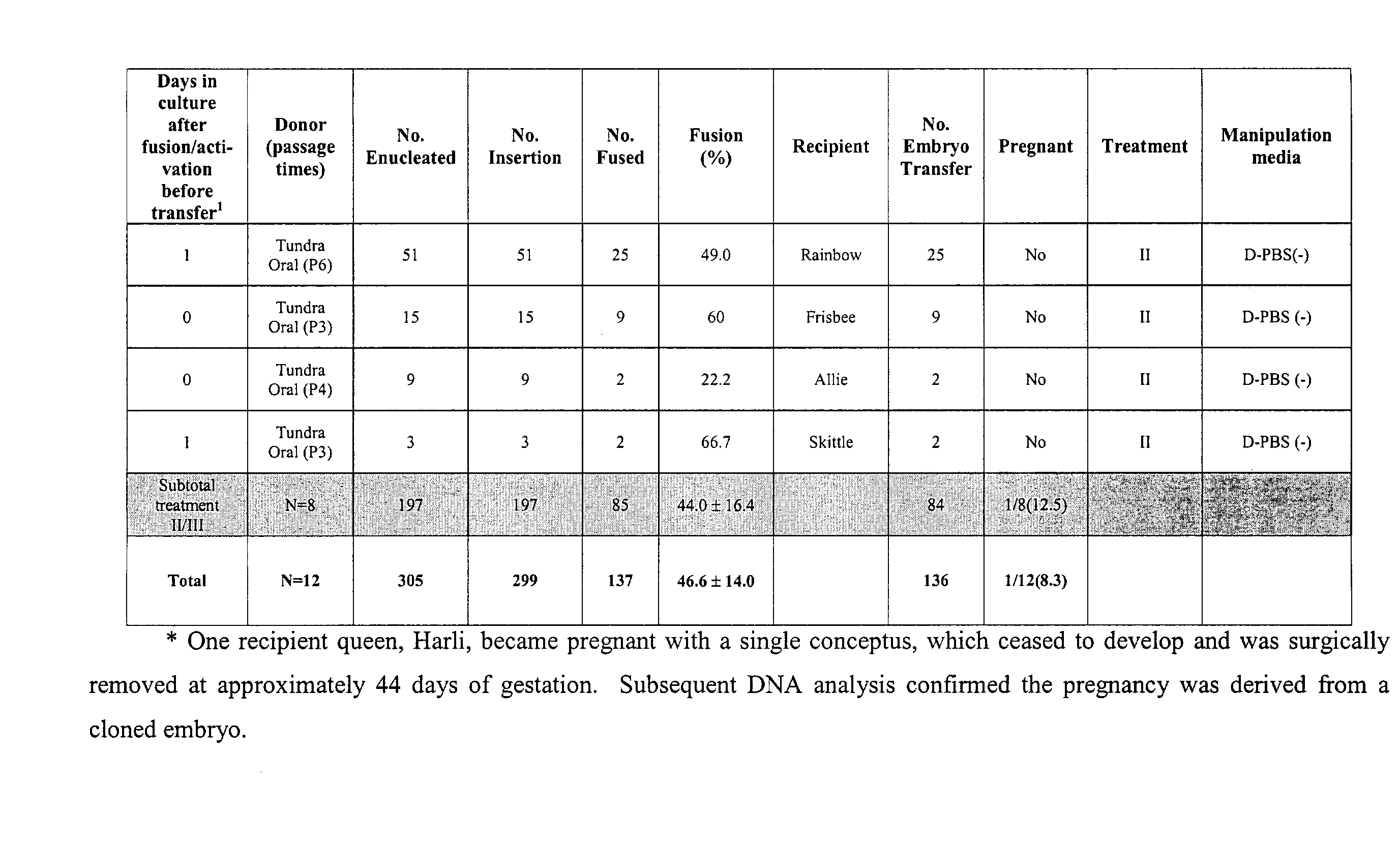Cloning cats by nuclear transplantation
a technology of nuclear transplantation and cat, which is applied in the field of cloning cats by nuclear transplantation, can solve the problems of affecting the efficiency of each step
- Summary
- Abstract
- Description
- Claims
- Application Information
AI Technical Summary
Benefits of technology
Problems solved by technology
Method used
Image
Examples
example 1
Nuclear Transplantation of Cybrids into Felines for the Production of
Cloned Embryos
[0101] A. Material and Methods
[0102] Animal Care and Use. Domestic short or long hair female cats were used for this study. The cats were cared for in facilities and using procedures, which exceed the standards established by the American Association for Accreditation of Laboratory Animal Care (AAALAC). Cats were purchased from Class A dealers and quarantined for 2 weeks prior to integration into the colony. The cats were fed commercially prepared balanced diets and maintained individually in temperature controlled, environmentally enriched kennels with visual contact with other cats. They were exercised, mostly in groups, for at minimum one hour per day. Individualized, positive reinforcement training was provided.
[0103] Chemicals. Unless otherwise indicated, all chemicals were purchased from Sigma (St. Louis, Mo.).
[0104] Oocyte Recovery and In Vitro Oocyte Maturation (IVM). Reproductive tracts from ...
example 2
Nuclear Transplantation Using Feline Nucleus Donor Cells Derived From Oral
Mucosa Of Adult Male Cat
[0118] Results of experiments involving nuclear transfer in cats are provided in Table 1 below. For treatment 1, 108 trials were performed resulting in 52 cloned cat embryos that were transferred into 3 synchronized recipient queens 1-3 days following nuclear transfer. No pregnancies were obtained. For treatment 2, 197 trials were performed to obtain 84 embryos, which were transferred into 8 recipients. One of these was diagnosed pregnant approximately 26 days following embryo transfer. Ultrasonography was used to monitor development of a single conceptus, which ceased to develop and was surgically removed at approximately 44 days of gestation. Subsequent DNA analysis confirmed the pregnancy was derived from a cloned embryo.
example 3
Nuclear Transplantation Using Feline Nucleus Donor Cells Derived from Cumulus Cells of Adult Female Cat
[0119] Due to the lack of success in the first experiment, a second cell line was derived from cumulus cells obtained from an adult female cat maintained in the cat colony, and utilized for nuclear transfer. In a single experiment, 3 cloned embryos derived from the cumulus cell line (details in Table 2) and 2 cloned embryos derived from fibroblast cells (Table 1, Recipient "Allie") were transferred into a recipient queen. Pregnancy was detected by ultrasonograpy at 22 days of gestation and a kitten was delivered by C-section 66 days following embryo transfer. The kitten appeared completely normal and was vigorous at birth.
[0120] Five additional experimental replications were carried out that involved nuclear transfer using cumulus cells derived from an adult cat, Rainbow. In brief, this was simply a replication of the experimental design that resulted in the birth of the cloned kit...
PUM
| Property | Measurement | Unit |
|---|---|---|
| temperature | aaaaa | aaaaa |
| temperature | aaaaa | aaaaa |
| temperatures | aaaaa | aaaaa |
Abstract
Description
Claims
Application Information
 Login to View More
Login to View More - R&D
- Intellectual Property
- Life Sciences
- Materials
- Tech Scout
- Unparalleled Data Quality
- Higher Quality Content
- 60% Fewer Hallucinations
Browse by: Latest US Patents, China's latest patents, Technical Efficacy Thesaurus, Application Domain, Technology Topic, Popular Technical Reports.
© 2025 PatSnap. All rights reserved.Legal|Privacy policy|Modern Slavery Act Transparency Statement|Sitemap|About US| Contact US: help@patsnap.com


